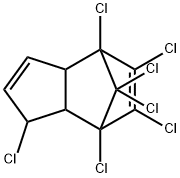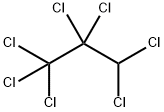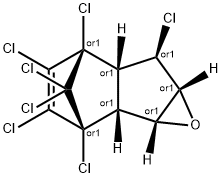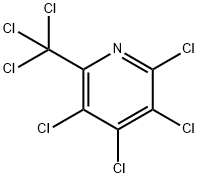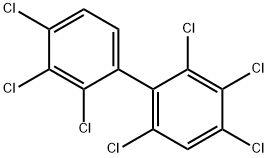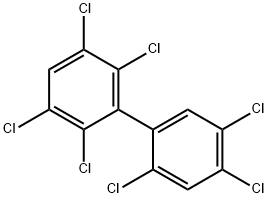Heptachlor solution , 1000 μg/ml, solvent: methanol , 76-44-8
Synonym(s):
1,4,5,6,7,8,8-Heptachloro-3a,4,7,7a-tetrahydro-4,7-methanoindene
CAS NO.:76-44-8
Empirical Formula: C10H5Cl7
Molecular Weight: 373.32
MDL number: MFCD00213497
EINECS: 200-962-3
PRODUCT Properties
| Melting point: | 96℃ |
| Boiling point: | 458.95°C (rough estimate) |
| Density | 1.6 g/cm3 |
| vapor pressure | 2.33(x 10-4 mmHg) at 25 °C (subcooled liquid vapor pressure calculated from GC retention time data, Hinckleyet al., 1990) |
| refractive index | 1.5407 (estimate) |
| Flash point: | 11 °C |
| storage temp. | APPROX 4°C |
| Water Solubility | 0.056 mg l-1 (25-29 °C) |
| Merck | 13,4675 |
| Henry's Law Constant | 0.19(x 10-3 atm?m3/mol) at 5 °C, 0.31 at 15 °C, 0.40 at 20 °C, 0.61 at 25 °C, 0.82 at 35 °C:in 3% NaCl solution: 0.52
at 5 °C, 0.82 at 15 °C, 1.33 at 25 °C, 2.09 at 35 °C (gas stripping-GC, Cetin et al., 2006) |
| Exposure limits | NIOSH REL: TWA 0.5 mg/m3, IDLH 35 mg/m3; OSHA PEL: TWA 0.5 mg/m3; ACGIH TLV: TWA 0.5 mg/m3. |
| Stability: | Stable. Non-combustible. Incompatible with strong alkali, oxidizing agents. Corrodes many metals. |
| IARC | 2B (Vol. Sup 7, 53, 79) 2001 |
| EPA Substance Registry System | Heptachlor (76-44-8) |
Description and Uses
Heptachlor is a soft, white to light tan, waxy, non-combustible, crystalline solid with a camphor-like odour. Heptachlor is a member of the cyclodiene group of chlorinated insecticides (aldrin, dieldrin, endrin, chlordane, heptachlor, and endosulfan) and has a long history following World War II. It was registered as a commercial pesticide in 1952 for foliar, soil, and structure applications and for malarial control programmes; after 1960, it was used primarily in soil applications against agricultural pests and to a lesser extent against termites. Heptachlor is available commercially as a dust, a dust concentrate, an emulsifiable concentrate, a wettable powder, or in oil solutions. It is corrosive to metals and reacts with iron and rust to form hydrogen chloride gas. Heptachlor is incompatible with many amines, nitrides, azo/diazo compounds, alkali metals, and epoxides but is stable under normal temperatures and pressures. It may burn, but does not ignite readily. Heptachlor at high heat and temperature produces highly toxic, corrosive fumes of hydrogen chlorine gas and toxic oxides of carbon. An important metabolite of heptachlor is heptachlor epoxide which is an oxidation product formed from heptachlor by many plant and animal species. Heptachlor is almost insoluble in water but soluble in ether, acetone, benzene, and many other organic solvents.
Heptachlor is used for the control of termites, ants, household insects and soil insects. It is also applied as a seed treatment, soil treatment or directly to foliage.
Safety
| Symbol(GHS) |    GHS06,GHS08,GHS09 |
| Signal word | Danger |
| Hazard statements | H300+H310-H351-H373-H410 |
| Precautionary statements | P202-P260-P273-P280-P301+P310-P302+P352+P310 |
| Hazard Codes | T,N,F,Xn |
| Risk Statements | 24/25-33-40-50/53-39/23/24/25-23/24/25-11-67-65-38-51/53 |
| Safety Statements | 36/37-45-60-61-62-16-7 |
| RIDADR | 2761 |
| OEB | C |
| OEL | TWA: 0.5 mg/m3 [skin] |
| WGK Germany | 3 |
| RTECS | PC0700000 |
| HazardClass | 6.1(a) |
| PackingGroup | II |
| Hazardous Substances Data | 76-44-8(Hazardous Substances Data) |
| Toxicity | LD50 in male, female rats (mg/kg): 100, 162 orally (Gaines) |
| IDLA | 35 mg/m3 |

